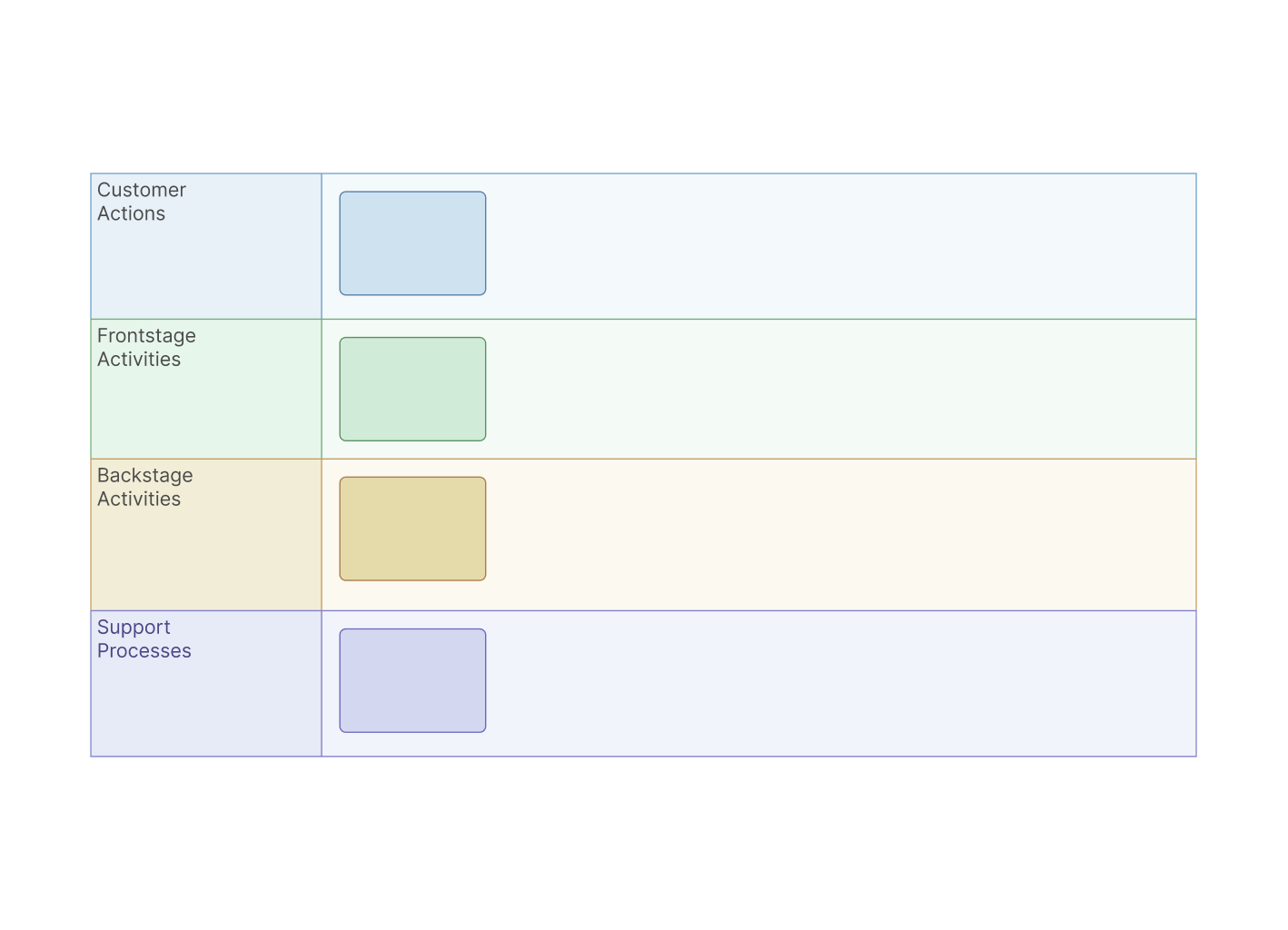A service blueprint is a visual map that shows how a service works—from what the customer experiences to what happens behind the scenes. It helps teams see the full picture, align better, and improve how services are delivered.
By mapping both the customer journey and internal operations, the service blueprint diagram makes it easier to spot issues, fix inefficiencies, and create better experiences.
In this guide, we’ll break down the top benefits of service blueprinting and why they’re a smart tool for any team.
The Top 10 Benefits of Service Blueprints
1. Aligns teams across functions
One of the biggest challenges in delivering a consistent service is keeping different teams on the same page. With a service blueprint, everyone—from customer support and marketing to IT and operations—can see how their work connects.
It becomes a shared reference that eliminates confusion, aligns goals, and improves cross-functional collaboration. For organizations struggling with siloed teams, this visual clarity is a game changer.
2. Improves customer experience (CX)
When you can visualize every step a customer takes and what supports it behind the scenes, it’s easier to identify where things go wrong. Service blueprints help teams spot friction points—like long wait times, confusing handoffs, or gaps in support—and fix them before they affect the customer.
This proactive approach helps build better experiences and boosts customer satisfaction.
3. Highlights operational inefficiencies
Many service issues don’t show up until you lay out the full process. Service blueprints help uncover hidden inefficiencies like duplicate tasks, unnecessary approvals, or disconnected tools.
By visualizing backstage activities and support processes, you can identify areas to streamline operations, reduce waste, and improve speed and quality across service delivery.
4. Supports better service design and innovation
Service blueprints make it easier to imagine “what if” scenarios by showing how a service currently functions. This creates space for innovation—whether it’s adding a new channel, rethinking a step, or simplifying a complex journey.
Teams can prototype and test changes in the blueprint before rolling them out, saving time and reducing risk.
5. Reduces risk in service delivery
Service blueprints reveal how different parts of your service depend on each other. This makes it easier to spot vulnerabilities—like delayed handoffs, system failures, or breakdowns in communication—and address them early.
Understanding these dependencies helps teams build more resilient services that work smoothly even when things don’t go as planned.
6. Enhances cross-channel consistency
Modern services often run across multiple channels—websites, apps, call centers, physical stores. Without a clear map, it’s easy for experiences to feel disconnected.
A service blueprint helps teams ensure that every touchpoint is aligned, delivering a consistent and seamless customer experience no matter where or how the service is accessed.
7. Enables empathy and customer-centricity
At its core, a service blueprint helps teams understand the service from the customer’s point of view. Seeing what the customer does, feels, and experiences helps everyone involved—from product to support—make more thoughtful, empathetic decisions.
It builds a shared understanding of user needs and customer pain points, leading to more human-centered service design.
8. Acts as a training and onboarding tool
New employees often struggle to understand how complex services work. A service blueprint offers a clear visual guide that shows how everything connects, who does what, and where they fit in.
It’s also helpful for sharing knowledge between teams or during team transitions, making employee onboarding faster and more effective.
9. Facilitates AI and automation planning
When planning to automate parts of a service, it’s critical to know which tasks are repetitive and rule-based—and which ones need a human touch. Service blueprints help identify automation opportunities while clarifying how human and machine roles work together.
They’re especially useful when designing AI-enhanced services, allowing you to integrate automation without disrupting customer experience.
10. Informs metrics and continuous improvement
Once your service is clearly mapped, it becomes easier to track what matters. Blueprints highlight where you should measure performance and what data matters most—whether that’s customer satisfaction, response times, or service quality.
They also support ongoing improvements by helping teams revisit and refine their workflows over time.
Creately Service Blueprint Examples to Get Started
Now that you’re familiar with the service blueprint advantages, you can get started right away on designing your own. Whether you’re mapping a simple customer service flow or a complex omnichannel journey, Creately offers a flexible visual workspace built for this purpose.
With Creately, you can:
- Use ready-made service blueprint templates to kick-start your design
- Access a full library of drag-and-drop shapes for mapping frontstage, backstage, and support processes
- Leverage the AI-powered service blueprint template to quickly generate and customize blueprints based on your input, saving time and boosting creativity
- Add data, notes, and links directly to blueprint elements for rich context
- Collaborate in real time with your team—no matter where they are
- Switch between visual views, documents, and tasks to take action right from the blueprint
AI service blueprint
Blank service blueprint
Restaurant service blueprint
Hospital service blueprint
Starbucks service blueprint
References
Abugeddida, R.A. and Donnellan, P. (2021). Service Blueprint Technique for Designing and Improving Service: A Literature Review. [online] ResearchGate. doi:https://doi.org/10.13140/RG.2.2.16423.88482.
Shahin, A. (2010). Service Blueprinting: An Effective Approach for Targeting Critical Service Processes – With a Case Study in a Four-Star International Hotel. Journal of Management Research, 2(2). doi:https://doi.org/10.5296/jmr.v2i2.352.
Experience, W.L. in R.-B.U. (n.d.). Service Blueprinting in Practice: Who, When, What. [online] Nielsen Norman Group. Available at: https://www.nngroup.com/articles/service-blueprinting-practice/.
FAQs About Benefits of Service Blueprints
Why is creating a blueprint for a test helpful?
How do service blueprints improve customer experience?
Can AI tools help create service blueprints?
How do service blueprints support continuous improvement?
Are service blueprints only for external customer services?
How do service blueprints relate to process maps?







